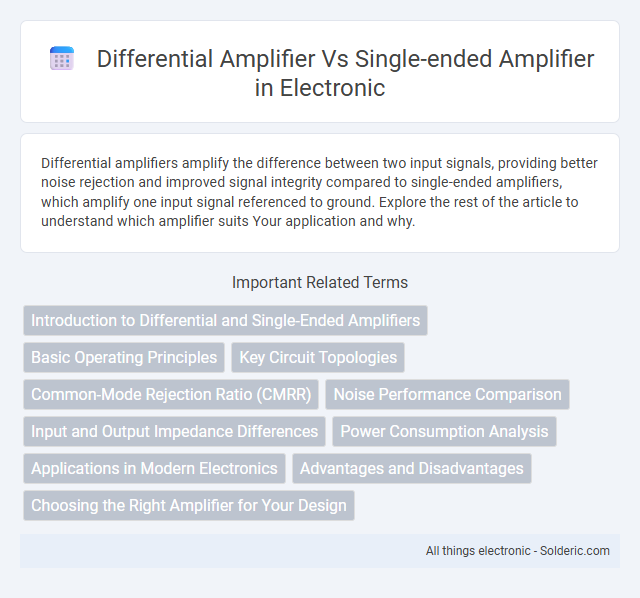Differential amplifiers amplify the difference between two input signals, providing better noise rejection and improved signal integrity compared to single-ended amplifiers, which amplify one input signal referenced to ground. Explore the rest of the article to understand which amplifier suits Your application and why.
Comparison Table
| Feature | Differential Amplifier | Single-Ended Amplifier |
|---|---|---|
| Input Signal | Two inputs (positive and negative) | One input signal referenced to ground |
| Output | Amplifies difference between inputs | Amplifies signal against ground |
| Common-Mode Rejection Ratio (CMRR) | High (rejects noise common to both inputs) | Low (cannot reject common noise effectively) |
| Noise Immunity | Superior noise rejection | More susceptible to noise |
| Typical Applications | Sensor signal conditioning, instrumentation | Basic audio amplification, simple signal amplification |
| Complexity | More complex circuit design | Simple circuit design |
| Power Consumption | Generally higher due to added components | Lower power requirement |
Introduction to Differential and Single-Ended Amplifiers
Differential amplifiers amplify the voltage difference between two input signals, offering high noise rejection and improved signal integrity in environments with common-mode interference. Single-ended amplifiers amplify a single input signal relative to a fixed reference, typically ground, which can result in higher susceptibility to noise and distortion. The choice between differential and single-ended amplification depends on the application's requirements for noise immunity, signal fidelity, and complexity.
Basic Operating Principles
Differential amplifiers amplify the voltage difference between two input signals, providing high common-mode rejection and enhanced noise immunity, making them ideal for sensitive measurement applications. Single-ended amplifiers amplify a signal referenced to ground, resulting in simpler design but lower noise rejection and sensitivity to interference. Understanding these basic operating principles is crucial for selecting the appropriate amplifier type based on signal integrity and noise considerations in electronic circuits.
Key Circuit Topologies
Differential amplifiers use paired input transistors arranged symmetrically to amplify the voltage difference between two signals, minimizing noise and interference, while single-ended amplifiers feature a single input transistor amplifying one input signal relative to ground. Key topologies for differential amplifiers include the long-tailed pair and the instrumentation amplifier configuration, both designed to enhance common-mode noise rejection and improve linearity. Single-ended amplifiers often employ common-emitter or common-source stages, prioritizing simplicity and gain at the expense of lower noise rejection compared to differential designs.
Common-Mode Rejection Ratio (CMRR)
Differential amplifiers exhibit a high Common-Mode Rejection Ratio (CMRR), enabling them to effectively reject noise and interference present equally on both input lines. Single-ended amplifiers typically have lower CMRR, making them more susceptible to common-mode noise and reducing signal fidelity in noisy environments. High CMRR in differential amplifiers is crucial for applications requiring accurate signal amplification with minimal distortion from external electromagnetic interference.
Noise Performance Comparison
Differential amplifiers excel in noise performance by rejecting common-mode noise and interference, resulting in higher signal integrity compared to single-ended amplifiers, which are more susceptible to external noise sources. The inherent design of differential amplifiers cancels out noise present equally on both input lines, significantly improving signal-to-noise ratio (SNR). In contrast, single-ended amplifiers amplify both the signal and noise on a single input, leading to increased noise floor and reduced overall fidelity in noisy environments.
Input and Output Impedance Differences
Differential amplifiers typically exhibit high input impedance on both inputs to minimize signal loading, while single-ended amplifiers generally have a lower input impedance on their single input. Output impedance in differential amplifiers is often designed to be low and balanced to drive differential loads effectively, whereas single-ended amplifiers usually have a low output impedance but only for a single-ended signal path. Understanding these impedance characteristics helps optimize your circuit design for noise rejection and signal integrity.
Power Consumption Analysis
Differential amplifiers typically consume more power than single-ended amplifiers due to their dual input stage and constant tail current biasing, which ensures improved noise rejection and signal integrity. Single-ended amplifiers often offer lower power consumption by utilizing a simpler circuit topology with a single input path, suitable for applications where power efficiency is critical. Understanding your application's power budget will help determine whether the slightly higher power draw of differential amplifiers is justified by their enhanced performance.
Applications in Modern Electronics
Differential amplifiers are widely used in modern electronics for applications requiring noise rejection and accurate signal amplification, such as in operational amplifiers, sensor interfaces, and communication systems. Single-ended amplifiers are preferred in simpler audio and RF circuits where cost and design simplicity are prioritized, such as in headphone amplifiers and basic signal conditioning. The choice between differential and single-ended amplifiers depends on factors like noise immunity, signal integrity, and the specific requirements of analog and mixed-signal systems.
Advantages and Disadvantages
Differential amplifiers offer superior noise rejection and improved signal integrity by amplifying the voltage difference between two inputs, making them ideal for precision applications and environments with significant electromagnetic interference. Single-ended amplifiers provide simpler design and lower cost but are more susceptible to noise and interference, limiting their effectiveness in noisy or high-precision settings. Differential amplifiers generally require more complex circuitry and higher power consumption, while single-ended amplifiers excel in straightforward, low-complexity signal amplification tasks.
Choosing the Right Amplifier for Your Design
Choosing the right amplifier for your design depends on the signal environment and noise considerations. Differential amplifiers excel in rejecting common-mode noise and interference, making them ideal for applications requiring high line noise immunity and precise signal amplification, such as sensor interfaces and communication systems. Single-ended amplifiers are suitable for simpler circuits with single-ended signals where cost and simplicity are priorities, but they are more susceptible to noise compared to differential configurations.
Differential amplifier vs Single-ended amplifier Infographic

 solderic.com
solderic.com